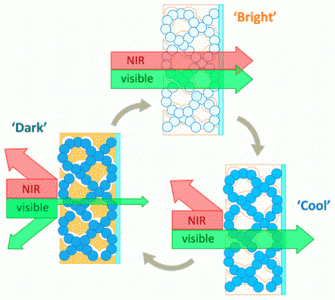Over coffee-stained research papers and crushed cans, the researchers at Cockrell School of Engineering at the University of Texas, Austin, are one step closer to delivering better, smarter windows with an entirely new type of energy efficiency. These windows are constructed with new materials that allow light in without transferring heat, or to transfer heat but not light. The ability to more precisely control the energy and light entering a home could greatly reduce the cost of heating, cooling, and lighting buildings.
In 2013, Professor of Chemical Engineering, Delia Milliron and her team became the first to develop dual-band electrochromic materials, which blend two different materials with distinct optical properties into one material that allows control of visible, and heat-producing near-infrared light (NIR). This nanocrystal material, when jolted with a small amount of electricity, could switch back and forth between its different properties, thus allowing control of heat and light independently.
Milliron and her team have been able to devise a new electrochromic material that selects between a “cool mode” and “bright mode”, something that was thought impossible at the onset of their research. This mode-switching material allows for control over ninety percent of the NIR energy, and eighty percent of the visible light that enters the window. This adjustment only takes minutes to switch between its modes, while previous materials took hours.

In order to achieve this level of performance, Milliron contracted the work of Jongwook Kim, a post-doctoral researcher at Cockrell, as well as Brett Helms of the Lawrence Berkeley National Lab. The team was able to develop a crystalline nanostructure that can block NIR, while allowing light from the visible spectrum through. Milliron states, “We believe our new architected nanocomposite could be seen as a model material, establishing the ideal design for a dual-band electrochromic material, this material could be ideal for application as a smart electrochromic window for buildings.”
In optimizing this nanomaterial for public use, the team organized the composites to create a porous interpenetrating network. This framework of nanostructures allows for electronic and ionic change to occur within the structure, allowing for considerably faster switching of modes. However, the current process to produce the material is far too expensive for widespread use, and the team is working to design a nanocomposite through simple methods that would be suitable for mass-production.
In a recent paper published in the American Chemical Society, Milliron proves that coating a window with a single component, such as doped titania nanocrystals, could demonstrate dynamic control over the transmission of solar radiation. Due to the distinct charging mechanisms found when different voltages are applied, the material can selectively block visible or infrared radiation.
“These two advancements show that sophisticated dynamic control of sunlight is possible,” Milliron said. “We believe our deliberately crafted nanocrystal-based materials could meet the performance and cost targets needed to progress toward commercialization of smart windows.”
Delia Milliron and Brett Helms both serve on the Scientific Advisory Board and own equity in the corporation Heliotrope Technologies, which has been allowed to utilize their research in order to create materials and manufacturing processes for development and sale of electrochromic devises with an emphasis on the rightfully-dubbed “Smart Windows.”
The University of Texas, Austin, and the research team received funding from the U.S. Department of Energy, the Welch Foundation, and the NSF Graduate Fellowship Program.
This article originally appeared on TheMittani.com, written by Kristoff Merkas.

